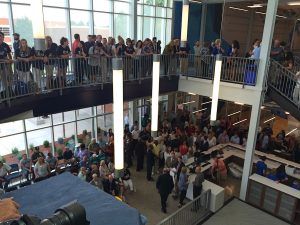Student-funded $11.5 million ‘Rock’ opens on UAFS campus
by August 22, 2016 7:56 pm 962 views

The $11.5 million Recreation and Wellness Center at the University of Arkansas at Fort Smith.
The University of Arkansas at Fort Smith has opened the doors on a new $11.5 million facility. The Recreation and Wellness Center (RaWC, and pronounced “Rock”) began as an initiative led by the Student Government Association (SGA) in 2013.
The university broke ground in 2015 and had its official ribbon cutting ceremony on Monday afternoon (Aug. 22) at the corner of North 51st Street and Kinkead Avenue for the student-funded, 47,000-square foot facility.
Students self-supported the activity fee increase of $5 per credit hour through a vote in 2013. The fee funds the facility and ongoing maintenance costs of $120,000 annually. The RaWC includes a 35-foot high rock-climbing wall, a 15-foot bouldering wall, an expanded fitness space, recreational lobby area, full-size basketball and volleyball courts, and additional rooms for multipurpose use. It also boasts a three-lane walking track, locker rooms and changing areas, and controlled entrance access with a card-swipe turnstile entrance for anyone with a UAFS ID.
Compared to the university’s previous facility, the RaWC will offer expanded free weight and strength training, additional cardio machines, and more group offerings like kickboxing, Pilates, yoga, spinning, boot camp, cardio dance, Zumba and aerobics classes, to name a few.
The basketball gymnasium portion is also double the square footage of the previous location, eliminating the prohibition that intramural and sport club organizations faced when the previous courts were reserved for official university sports.
UAFS Chancellor Dr. Paul Beran said the center is a welcome addition to the campus in public comments at Monday’s ribbon cutting.

“The Recreation and Wellness Center is an important addition to our campus. We are excited to open such a state-of-the-art facility for our campus community because emphasizing fitness and wellness makes UAFS an institution that educates the whole student,” Beran said. “Study after study link the ability to maximize intellectual pursuits with wellness. The students, staff and faculty who use this new facility are creating lifelong health habits that can lower illness and enhance critical and creative thinking.”
Beran praised the efforts of the SGA, acknowledging that the vote was not lopsided and there was a fair amount of debate between supporters of the increased fees and their opposition. While Beran did not provide a voting breakdown at the event – and the university was unable to attain those numbers at the time of this post – the SGA’s get-out-the-vote effort resulted in triple the participation from previous student elections, ultimately passing the resolution and setting it up for a presentation to the UA System Board in March of 2014.
Beran said the Board did not go easy on student representatives when questioning them on their commitment to the project, but they ultimately approved with a unanimous vote.
“This was a student-led effort,” Beran said, adding that “while people like me get credit,” it was the SGA and personnel like Meighan Pendergrass, director of campus recreation and wellness, who ensured the project started and finished on time. While the SGA’s goal was to make something “for the students,” Beran said, it was also important for them to open the facility for use by UAFS faculty and staff, “for the support and the encouragement they’ve given to our students.”
